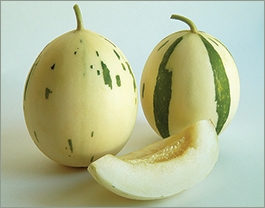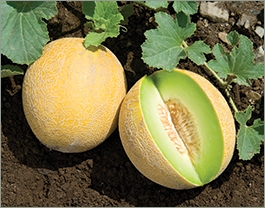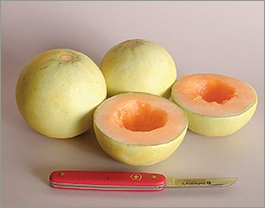To all the lovely people,
I know it's early but you might want to put this in you garden file for future reference. Please write if you have any questions please keep in ming that Organic Compost Tea is always available. Have great Christmas and may 2014 be our best gardening year ever.
Paul
------------------------
Assure Your Melon-Growing Success
Rediscover the Perfect Melon
A perfectly ripe, fresh-market melon is one of the great taste treats of the produce world. Sweet and fragrant, with a texture that practically melts in the mouth, a well-grown, local melon is far superior to its supermarket counterpart. Most of the melon varieties favored by grower-shippers selling to supermarkets have been bred to withstand the rigors of shipping and handling, for good shelf life and, to make matters worse, are often picked before fully ripe to further enhance their shelf life. Flavor is subservient to firmness and shelf life for these melons. Melons provide a unique niche for local market gardeners who can grow them to full ripeness, handle them gently, then deliver a product generally not available in supermarkets. And once consumers taste such a melon, they will not go back to the supermarket types. In this article, we review the basics of successful growing, harvesting, storing, and selling melons. With Johnny's expansive line of melons, including many that are selected for adaptability to challenging growing conditions, even a small grower has access to superb melon genetics. With the right varieties and knowledge, you can produce melons — including organic and heirloom varieties — that will win over the most discerning buyers, chefs, and guests. |
|||||||||||||||||
Planting Know-How

A common challenge for melon growers is damping-off of seedlings. To prevent this problem, sow seeds in flats using a slightly drier medium than typical for most other crops. Water with care and allow media to become moderately dry between waterings. Adequate air circulation is essential. If necessary, position small fans over greenhouse benches. To avoid root damage when transplanting, grow melons in large cells, 50 or 72 cells per tray, so the plant can size up sufficiently before setting out. Take care to handle seedlings gently to reduce transplant shock and enhance field performance. After transplanting, water in seedlings with fertilizer solution. Melons are typically grown on plastic mulch to warm the soil and prevent weeds. In cooler areas, solar mulch is recommended because it warms the soil better than black plastic. In the South, most growers grow melons only in spring to avoid the high heat of midsummer, though some also grow a fall-maturing crop.
Once the vines begin to run and the first flowers appear, remove the row covers to allow for pollination. An important note on irrigation! The plants should be irrigated regularly until the fruits are full-sized but not ripe. Drip irrigation is recommended to prevent excess water on foliage, which can lead to disease. When the fruits are close to being ripe the crop should not be watered unless the plants are showing obvious heat stress such as wilting. Irrigating when the fruits are ripening will result in bland, watery fruits. Low tunnels with vented plastic are another option, if melon prices justify the added expense. They allow for earlier spring crops and later fall crops. Low tunnels also protect the crop from excessive rain and provide more heat for young plants. Use landscape fabric between rows if the added cost can be justified. Be sure to roll up the sides of the tunnel during the day once flowering begins, to allow for pollination. Getting the Most from the Growing SeasonMultiple plantings can be made to stagger ripening of your melon crop and extend the harvest window. In the North, plants can be set out after the danger of frost has passed, from May through mid June. In warmer areas, they should be transplanted in March and April. Although there is some opportunity for making one planting with staggered days-to-maturity, it is limited. In general, most melons have relatively similar days-to-maturity, so making multiple plantings is the preferred method of extending the harvest. When to Harvest

Determining ripeness in a melon is a combination of art, science, and experience but is not difficult if one pays attention to the criteria for determining when the various types are ready. Most varieties are ripe at full or forced slip. It takes a little practice to recognize full or forced slip, but basically you want to look where the stem attaches to the fruit. When that area shrinks, it's time to test for ripeness. If the variety is said to be ripe at full slip, that means the stem can be easily detached with a slight push of the thumb. Half slip means you have to use more pressure with your thumb to detach it. Other harvest indicators can include when the skin colors and the fruit softens a bit. With Charentais and honeydew melons, there is a small, long-stemmed leaf attached to the vine at the same point as the fruit. At ripeness, this leaf yellows. For more details on when to harvest the various types of melons, refer to the product and category descriptions provided in our catalog or website. Melon StorageNetted melons store best at 36–41°F (2–5°C) and 85–95% humidity. Store other melons types at 45–50°F (7–10°C) and 85–95% relative humidity. All will hold for a few days without refrigeration, but will hold longer if chilled. Note that storage periods are educated guesses, and that the variety and the ripeness of the fruit when harvested will affect the duration. Shelf life can be ranked as follows:
Melon Marketing TipsMixed displays of melons are popular at farmers' markets, and a great way to encourage customers to try new varieties. If sampling is allowed at your market, offering a sampling of fresh, fragrant chunks of melon on toothpicks will also help sell them. Restaurants often sell plates of sliced melons, so offering several varieties can increase sales. Melons are part of the "culinary cocktail" trend, used to adorn numerous drinks. Ethnic markets can be important sales channels for melons. For example, Korean and Chinese customers will appreciate Sun Jewel in particular, and most Asian markets would be receptive to all honeydews. Ananas and Galia are popular with folks from the Mideast, and French chefs will be excited about finding the all-too-rare Charentais melons. |
|||||||||||||||||
Learn More
While there is a learning curve to growing melons successfully, once you've mastered the techniques, they can be a rewarding and profitable crop.
If you're thinking of including melons in your growing plans this year, give us a call and let us help.
Here are some additional resources to get you started:
- Cornell University's Integrated Crop & Pest Management Guidelines for Commerical Vegetable Production have recently been updated. See Chapter 18, Part 1, Cucurbits »
- Clemson University provides extensive Information on Diseases of Melons and Other Cucurbits. »
- For information about safe handling, see Cantaloupe: Safe Methods to Store, Preserve, and Enjoy from the University of California at Davis

